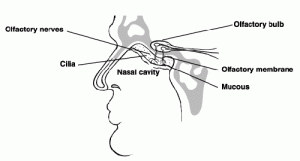A viral sniff
A common virus may get to the brain through the nose
The human nose is like a door to the body, letting in smells and sending out sneezes. According to a new study, a common virus may use the nose as a highway into the brain.
The virus is called human herpesvirus-6, or HHV-6. A virus is a microscopic glob that can cause an infection once inside the human body. The possible nose-dwelling virus can cause roseola, an infection that comes with a high fever and a chest rash. Maybe you haven’t heard the name HHV-6 before, but there’s a good chance your body knows it.

HHV-6 is tricky. It attacks nerve cells in the body. Nerve cells are like high-speed messengers that carry information all over the body. The human brain contains about 100 billion of the cells (or about 15 times as many as there are people on the planet).
Roseola isn’t the only infection connected to HHV-6. This germ has also been associated with more serious diseases like encephalitis and epilepsy. (Encephalitis is a swelling of the brain, and epilepsy causes people to have severe seizures.) Once researchers know how the HHV-6 virus enters the body and attacks nerve cells, they can home in on strategies to stop it.
Other nerve-targeting viruses, like those that cause flu and rabies, get to the brain through the nose. To find out if HHV-6 did too, Jacobson and his colleagues examined brain tissue from autopsies. (After a person dies, an autopsy, or a study of the body, can reveal the cause of death and help scientists learn more about diseases.)
In two of the three autopsy samples studied, the scientists

Though the scientists found HHV-6 in the olfactory bulb, they still needed to see if the virus reached the olfactory bulb by way of the nose. So they looked for signs that the virus had visited the nasal cavity first. The team studied 126 samples of mucus — the gunk also known as snot — and found the virus 52 times.
“We were surprised to find so much in the nasal mucus,” Jacobson told Science News.
This evidence suggests that the virus comes in through the nose, settles in the nasal cavity and then infects cells in the olfactory bulb. The infection may spread from cell to cell until it reaches other parts of the brain.
On the other hand, Jacobson’s team might be mistaken, says Robyn Klein. She studies infectious diseases at Washington University in St. Louis. She notes that the new study used only a small number of samples. “Am I convinced that this is how it gets in? No,” she told Science News. “Is it a possibility? Sure.”
This story and other Science News for Kids articles describing research in medicine and biology are supported with funding from The Lasker Foundation. The foundation and its programs are dedicated to the support of biomedical research toward conquering disease, improving human health, and extending life.







